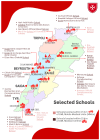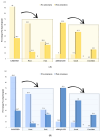School-Based Pre- and Post-Intervention Tests Assessing Knowledge about Healthy Lifestyles: A National School Health Awareness Campaign on Children Aged between 3 and 12 Years Old
- PMID: 38397325
- PMCID: PMC10887629
- DOI: 10.3390/children11020213
School-Based Pre- and Post-Intervention Tests Assessing Knowledge about Healthy Lifestyles: A National School Health Awareness Campaign on Children Aged between 3 and 12 Years Old
Abstract
In response to the diverse health challenges faced by today's youth and their extensive time spent in schools, we conducted a school health awareness campaign aimed at prioritizing well-being and academic performance. This analytical longitudinal study, spanning 27 schools in Lebanon, aimed to assess the impact of the awareness campaign on the health knowledge and practices of 5-, 8-, and 11-year-old students throughout pre- and post-intervention testing focused on general health and healthy habits, employing 11, 14, and 15 questions tailored to 5, 8, and 11 year olds, respectively. The questions covered various aspects, including sleep, personal and dental hygiene, nutrition, physical activity, addiction, security measures, and bullying. Out of the 7100 students who participated, 16.11% (1144 students) were evaluated before and after the campaign. The results indicated a significant increase in health awareness post-intervention across all age groups. For instance, in 5-year-olds, limited awareness decreased from 91.6% to 36.38%, while adequate awareness rose from 8.03% to 62.3%. Improvement varied across health knowledge topics, with security-related questions showing the highest enhancement. Factors such as governorate, normal-weight status, and close supervision influenced improvement. However, no significant correlations were found with school type, size, gender, age, nationality, parental factors, or comorbidities. The study concludes that the school health awareness campaign successfully heightened children's health awareness, advocating for the integration of regular health promotions into the standard educational curriculum.
Keywords: Lebanon; awareness campaign; children; health; intervention; knowledge and practice; schools.
Conflict of interest statement
The authors declare no conflicts of interest.
Figures






References
-
- World Health Organization Health Promotion: Enhanced-Wellbeing: The 1st International Conference on Health Promotion, Ottawa, 1986: Ottawa Charter for Health Promotion. [(accessed on 14 February 2023)]. Available online: https://www.who.int/teams/health-promotion/enhanced-wellbeing/first-glob....
-
- Boyer E.L. High School: A Report on Secondary Education in America. Reprint; Harper & Row; New York, NY, USA: 1983.
Grants and funding
LinkOut - more resources
Full Text Sources

